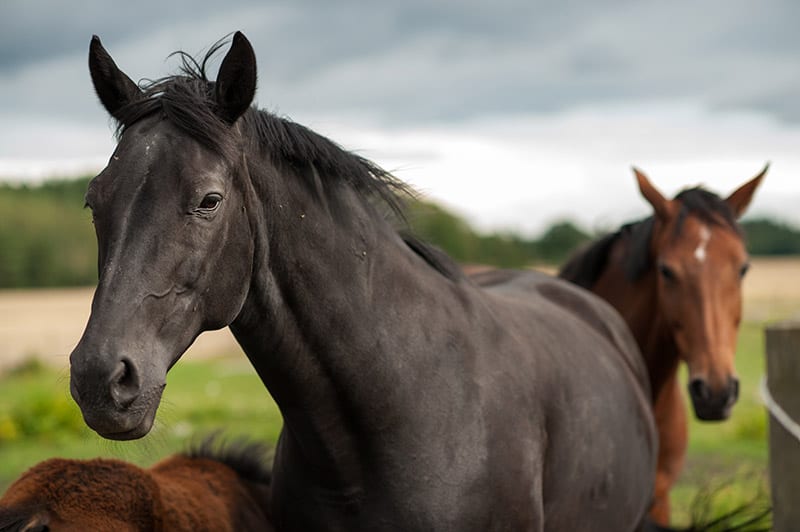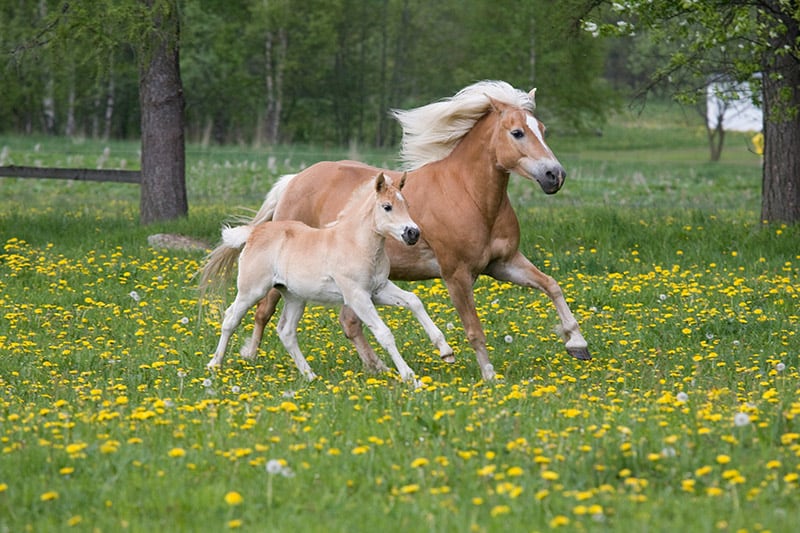Producing baby horses is very exciting but there are many points to consider before jumping in!
Successful horse breeding takes understanding normal breeding behavior. A novice may want to seek professional help with this breeding process, especially with mating and foaling. Ideally a mare should have an examination by a veterinarian before being bred to make sure that her reproductive system is normal.
The horse breeding and reproduction is a progression similar to that of other mammals. It starts with a mare in heat, followed by mating or artificial insemination to provide conception and a pregnant mare. But this is just the beginning. Once a mare has conceived the pregnancy progresses through the development of an embryo then turning into a fetus, and finally the mare giving birth to a newborn foal.
Taking care of a pregnant horse until the mare gives birth is crucial, and will span eleven months. Once the mare is ready to give birth, it is then essential to know how a newborn foal should behave and develop. Newborn baby horses are fragile for the first few hours, and its important to know how to care for a foal. Once past all these crucial stages the reward is great. Baby horses themselves are fun to raise into wonderful companion animals.
Learn about all types of horse breeds:
Horse Mating
Horse mating begins with a mare in heat. Most mares (female horses) will come into heat every month and are usually in heat for several days. No matter how long a mare is in heat, the fertile period or ovulation will occur for 24 to 48 hours at the end of the heat cycle. To assure a mare gets pregnant, most breeders will begin breeding the mare on the second day she is in heat and every day after until she goes out of heat. If the mating is successful then long gestation period begins.

Horse Artificial Insemination (AI)
Horse breeding can be done naturally through horse mating, or by artificial insemination. Benefits to horse artificial insemination are that it eliminates the risk of injury that comes with natural breeding and the spread of venereal disease. Usually AI is done at the breeding facility where the stallion is located so that the semen does not need to be frozen, but it is possible to have frozen semen shipped to the mare.
Pregnant Horse
To find out if horse mating or artificial fertilization were successful, there are horse tests and other signs help to determine if a mare is pregnant. Signs that your mare is pregnant include the ending of her heat cycle, mood changes, fattening of her abdomen, and reluctance to exercise.
A horse tests can also help to determine if a mare is pregnant. To find out if you have a pregnant horse a veterinarian can perform a rectal palpation as early as 20 to 45 days after breeding. A blood test is another horse test that is also available for pregnancy testing mares. This test checks hormone levels in the blood stream to determine if you have a pregnant horse. It is over 97% accurate at 41 to 45 days of pregnancy and can be used up to 100 days of pregnancy.
Pregnant Horse Care
Equine pregnancy lasts for eleven months. Taking care of a pregnant horse is crucial. During this time, the mare should be adequately exercised. She can be exercised normally up until about the last two months, and then long walks will help keep her in good condition. Do not stop exercising her.
Good nutrition is also a very important part of taking care of a pregnant horse. During pregnancy make sure the mare has plenty of roughage, and a vitamin supplement is advisable. She should receive a tetanus booster four to eight weeks before she foals so that the immunity is passed on to the foal.
Two weeks before the mare’s expected due date, she should be moved into a stable suitable for foaling. It needs to be large enough for her to lay down comfortably. Provide suitable dust-free bedding (straw is preferable) and make sure it is free of cold drafts.

Horse Birth
A normal horse birth will take 15 to 45 minutes. Baby horses are normally born front feet first with the head between the legs. If part of the foal is showing and it is not positioned front feet first, call a veterinarian immediately. A mare giving birth will usually foal without complications, as only about 10% of equine births require assistance.
As soon as the face is exposed, remove the membranes and mucus from the baby horses mouth and nose. Make sure that he is breathing properly, and, if not, try reaching your hand as far as you can into his throat to remove mucus. You can also try stimulating him by dousing him with a glass of water or tickling his nose with straw. If the placenta is still attached, you can leave it until the foal moves or the mare stands, which will allow the last bit of blood to be pumped into his body.
The umbilical cord has a natural breaking point that should separate. If this does not happen, you can loosely tie some baling twine around it six or seven inches from the foal and cut it on the side away from the foal. Then dip the foal’s naval in iodine to prevent infection. This can be done again 12 hours later. The mare should pass the membranes within one to two hours.
Baby Horses
It’s important that your are prepared to take care of a foal. After birth, baby horses should be allowed to struggle and rise on their own, which will make them stronger. Try not to interfere too much in the first couple hours after birth. This is a critical time for bonding between the mare and foal, and ultimately the care of the foal.
If the foal is not nursing within three hours, you can take some milk from the mare and feed him by bottle. If the mare is not letting him nurse, you may have to sedate or restrain the mare. The milk that is produced during the first few days after foaling is called “colostrum” and is very rich in vitamins and antibodies that are essential to the early development and health of the foal.
Featured Image Credit: Lenkadan, Shutterstock
